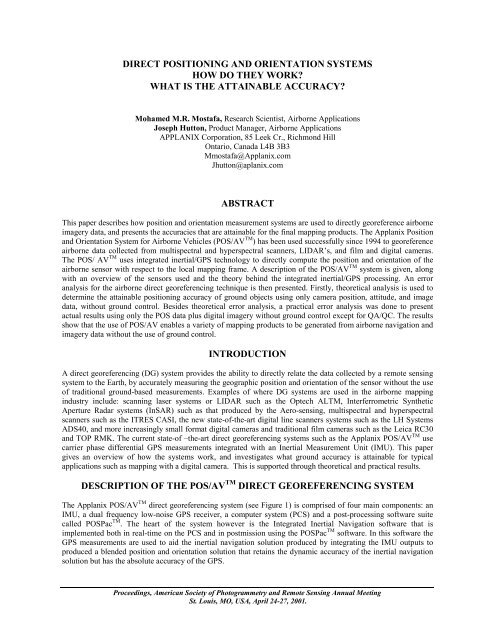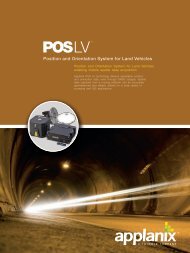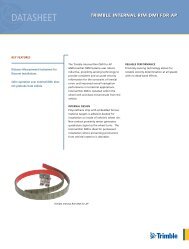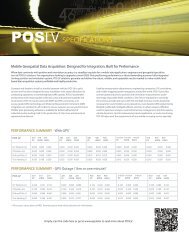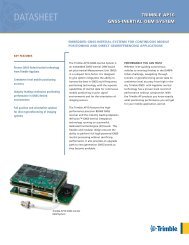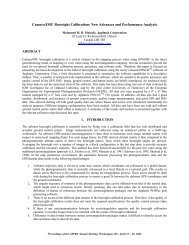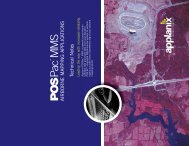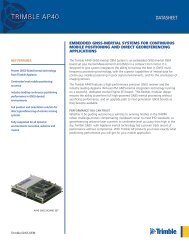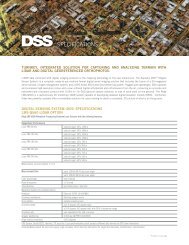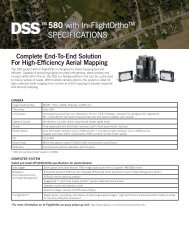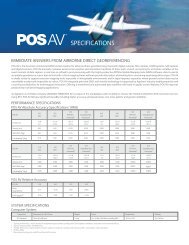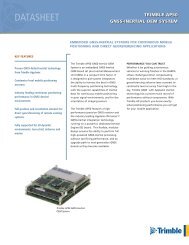Read... - Applanix
Read... - Applanix
Read... - Applanix
You also want an ePaper? Increase the reach of your titles
YUMPU automatically turns print PDFs into web optimized ePapers that Google loves.
Kalman filter will only be able to estimate the roll and pitch error down to the level where the misresolved gravitycancels out the accelerometer biases.Heading AccuracyAs described above in the In-Air Alignment section, the heading error is observed primarily through accelerations.During straight-and-level flight with little or no accelerations, the heading error will grow at a rate defined by thegyro noise and residual gyro bias. As soon as a significant acceleration is experienced, the heading error will beobserved and the error reset (see Figure 6). The smoother will then extrapolate the reset backwards in time toreduce the overall error (see Figure 7). Hence in order to maintain heading accuracy to the maximum level, it isimportant that a maneuver be performed periodically (usually every 10 to 30 minutes, depending upon the qualityof the IMU, which is typically not a problem for aerial survey missions).Heading Error, Forward in TimeHeading Error, SmoothedTimeManeuversFigure 6. Heading Error Improvementafter maneuvers (Forward Solution)ManeuversFigure 7. Heading Error Improvementafter maneuvers (Smoothed)The post-processed absolute accuracy for each POS/AV TM model is given in Table 1, for a typical survey missionprofile including turns every 10 minutes or so. The post-processed relative orientation accuracy for eachPOS/AV TM model is given in Table 2.Table 1. Post-processed POS/AV TM Absolute AccuracyParameter Accuracy(RMS)POS/AV TM210POS/AV TM310POS/AV TM410POS/AV TM510Position (m) 0.05 –0.30 0.05 –0.30 0.05 –0.30 0.05 –0.30Velocity (m/s) 0.010 0.010 0.005 0.005Roll & Pitch (deg) 0.040 0.013 0.008 0.005Heading (deg) 0.080 0.035 0.015 0.008Table 2, Post-processed POS/AV TM Relative Orientation AccuracyParameter Accuracy POS/AV TM210POS/AV TM310POS/AV TM410POS/AV TM510Random Noise(deg/sqrt(hr))0.20 0.15 0.07 < 0.01Residual Bias(deg/hr), 1 sigma0.75 0.5 0.5 0.1
DIRECT GEOREFERENCING OF DIGITAL IMAGES USING POS/AV TMDirect digital image georeferencing using POS implies the direct measurement of position and orientation of eachsingle image frame or scan line at the moment of data acquisition. In principal, this allows immediate mapproduction using the photogrammetric unit (either a stereopair of images, or a single image+DEM). Ultimately,this approach totally bypasses the aerotriangulation step with no ground control point requirement, except for Q/Aand Q/C. Figure 8 shows the georeferencing concept.c-FrameR Mcz cEy cr cgs gR M crcgx cY MGr ME r MG Z M X MMapping FrameFigure 8. Image GeoreferencingIn this context, a brief description on the subject is presented and the obtainable accuracy is introduced usingtheoretical and practical analysis. Certain Calibration aspects have to be dealt with to ensure successful mapproduction with no aerotriangulation or ground control. Therefore, calibration will be briefly highlighted.Digital Orthophoto Production Data FlowAs shown in Figure 9, a typical Orthophoto production project includes calibration, navigation data processingand image data processing. The calibration consists of imaging sensor calibration (e.g., a digital camera),boresight calibration, and lever arm calibration. The Earth-Fixed Earth-Centered (ECEF) position and orientationangles derived by POS/AV TM , as shown in Figure 3, are compensated for the boresight and lever arm calibrationparameters The trajectory parameters are then interpolated at the recorded camera events and transformed into therequired local mapping frame (M-frame) using POSEO TM . If the calibration parameters are not available,POSEO TM solves for them using the navigation and image data. This yields the exterior orientation (EO)parameters of each single image frame or scan line coordinatized in the local mapping frame (X, Y, Z, ω, φ, andκ). In a Softcopy, image data and exterior orientation data are processed either in single image mode or in stereomode to produce ortho mosaics using either available DEMs or produced DEMs from stereo imagery,respectively.Ground Accuracy From Theoretical AnalysisThe necessary error models have been developed for two different cases of orthophoto production, namely, usingeither a single digital image or an image stereopair. Some assumptions have been made to account for differentpractical aspects. As an example of these theoretical studies, a specific case was studied which involved a digitalcamera of a 3k x 2K CCD chip and a 28 mm lens. This example is presented due to the availability of a realairborne data set to back up the theoretical analysis. Figure 10 depicts the horizontal DRMS theoretical accuracy(in left panel) and the height accuracy (in right panel) when using a stereo model of digital images for differentGround Sample Distance (GSD) when using POS/AV TM 210, 310, 410, and 510, respectively. Figure 11depictsthe horizontal DRMS theoretical accuracy using a single digital image and 1 foot accuracy DEM (in left panel)and the horizontal DRMS theoretical accuracy using a 10 feet DEM (in right panel). Note that Figures 10 and 11show the accuracy at image/model edge to represent worst case scenario. In practice, however, image points willnot all be at image or model edge.
CalibrationCameraCalibrationBoresightCalibrationLever ArmCalibrationPPPPPFocal LengthPP OffsetsLens DistortionsPixel SquarenessetcPPCamera/IMUetcPPPAntenna/IMUCamera/AntennaetcPOSPac TMPOSEO TMP Interpolation @ CameraEventsP Datum TransformationP Boresight CalibrationP Camera CalibrationP XYZ, ω φ κ (M-frame)POSProc TMP Position (ECEF)P Attitude (ECEF)P Velocity (ECEF)P etcSoftCopyDEMStereo ImagerySingle ImageryDOQFigure 9. Digital Orthophoto Production Data FlowAccuracy in Horizontal DRMS (m)1010.11,200/360/0.1 2,400/720/0.2 3,600/1100/0.25Flight Altitude (ft/m/GSD)Accuracy in Vertical (m)1010.11,200/360/0.1 2,400/720/0.2 3,600/1100/0.25Flight Altitude (Feet)Figure 10. Ground Horizontal Accuracy (Left) and Height Accuracy (Right) Using a Stereo ModelFor a 3k x 2k Digital Camera Equipped with a 28 mm LensGround Accuracy From Practical AnalysisA flight test data was collected using POS/AV 410 and a digital frame camera of 3k x 2k and 28 mm lens. Thedigital camera was calibrated to compute the focal length, the principal point offsets, and the lens distortionparameters. Boresight calibration took place to determine the misalignment angles between the IMU body frameand the image coordinate frame. The lever arms were calibrated using POSEO TM utilizing the measured lever arms
etween the GPS antenna, the IMU center, and the camera lens perspective center. The airborne navigation datawas processed in POSPac TM .Accuracy in Horizontal DRMS (m)1010.11,200/360/0.1 2,400/720/0.2 3,600/1100/0.25Flight Altitude (ft/m/GSD)Accuracy in Horizontal DRMS (m)1010.11,200/360/0.1 2,400/720/0.2 3,600/1100/0.25Flight Altitude (ft/m/GSD)POS/AV 210 POS/AV 310 POS/AV 410 POS/AV 510Figure 11. Ground Horizontal Accuracy Using a Single Digital Image + DEM For a 3k x 2k Digital CameraEquipped with a 28 mm Lens for a 1 ft DEM Accuracy (left) and for a 10 feet DEM Accuracy (right)The image data together with POS data were used to compute the coordinates of the ground control points thatappeared in different stereo models. A total of 20 models have been analyzed to account for different pointlocation in the model. The POS-derived ground coordinates were then compared to the land-surveyed ones. Theresults are shown in Table 3.SUMMARY AND OUTLOOKIn this paper, a brief description of direct georeferencing systems has been introduced through <strong>Applanix</strong>’s POSsystems. The basic concepts of inertial GPS integration have been described, along with the accuracy that can beachieved using such techniques.. Then the ground accuracy using POS integrated with a digital frame camera wasanalyzed. The results show that direct georeferencing can be used to obtain digital orthophotos to an accuracy thatcan meet many mapping or remote sensing requirements.Ongoing research and analysis at <strong>Applanix</strong> include defining a standard procedure for quality control for faultdetection and repair including but not limited to: boresight calibration residual errors, residual y-parallax, cameracalibration errors.
Table 3. Ground Point Accuracy Derived by POSCompared to GCP Surveyed ReferenceModel ID Easting (m) Northing (m) Horizontal (m) Height (m)1 -0.08 0.10 0.13 -0.592 0.07 -0.10 0.12 -0.113 0.13 0.09 0.16 0.884 0.38 -0.18 0.42 -0.025 -0.24 0.01 0.24 0.716 -0.18 -0.32 0.37 -0.407 0.19 -0.08 0.20 0.008 -0.07 0.07 0.10 -0.459 -0.25 -0.05 0.25 0.3410 0.06 0.20 0.21 -0.1511 0.28 -0.10 0.30 0.2812 0.13 -0.37 0.39 0.3913 0.35 -0.20 0.40 -0.0514 0.09 0.17 0.19 0.5215 0.34 -0.02 0.34 1.3416 -0.06 0.06 0.09 0.3017 -0.21 0.15 0.25 -0.0118 -0.04 -0.34 0.34 0.5319 0.21 -0.10 0.24 0.0320 -0.20 -0.11 0.23 -0.64Statistical SummaryMin -0.25 -0.37 0.09 -0.64Max 0.38 0.20 0.42 1.34Mean 0.04 -0.06 0.25 0.15Std 0.21 0.17 0.10 0.50RMS 0.21 0.18 0.27 0.52REFERENCESASCE, 1996. Photogrammetric Mapping - Technical Engineering and Design Guides as Adapted from The USArmy Corps of Engineers, No. 14, American Society of Civil Engineers Press.FGDC, 1998, Geospatial Positioning Accuracy Standards, FGDC-STD-007.3-1998, Part 3: National Standard forSpatial Data Accuracy (NSSDA).Fraser, C.S., 1997. Digital Camera Self Calibration, ISPRS Journal of Photogrammetry & Remote Sensing,52(1997): 149-159.Hutton, J., Savina, T., and Lithopoulos, L., 1997. Photogrammetric Applications of <strong>Applanix</strong>’s Position andOrientation System (POS). ASPRS/MAPPS Softcopy Conference, Arlington, Virginia, July 27 - 30.Merchant, D.C., 1982. Analytical Photogrammetry - Theory and Practice, Part II, Department of Geodetic Scienceand Surveying, The Ohio State University.Moffit, F., and E.M. Mikhail, 1980. Photogrammetry, Harper and Row, Inc., New York, 648 p.Mostafa, M.M.R., J. Hutton, and E. Lithopoulos, 2001. Direct Georeferencing of Frame Imagery - An ErrorBudget. Proceedings, The Third International Mobile Mapping Symposium, Cairo, Egypt, January 3-5.Mostafa, M.M.R. and K.P. Schwarz, 2000. A Multi-Sensor System for Airborne Image Capture andGeoreferencing. PE&RS, 66 (12): 1417-1424.Reid, D.B., E. Lithopoulos, and J. Hutton, 1998. Position and Orientation System for Direct Georeferencing(POS/DG), Proceedings, Institute of Navigation 54 th Annual Meeting, Denver, Colorado, USA, June 1-3,pp. 445-449.Scherzinger, B., 1997. A Position and Orientation Post-Processing Software Package for Inertial/GPS Integration(POSProc). Proceedings of the International Symposium on Kinematic Systems in Geodesy, Geomaticsand Navigation (KISS 97), Banff, Canada, June 1997.Schwarz, K.P., M.A. Chapman, M.E. Cannon, and P. Gong, 1993. An Integrated INS/GPS Approach to theGeoreferencing of Remotely Sensed Data, PE& RS, 59(11): 1167-1674.


